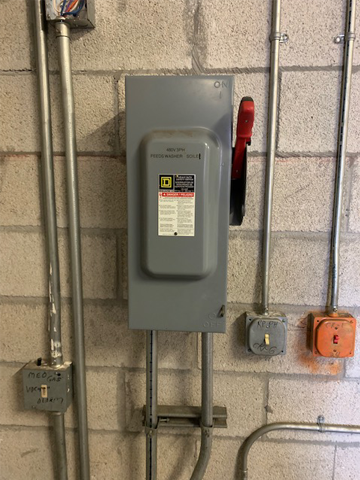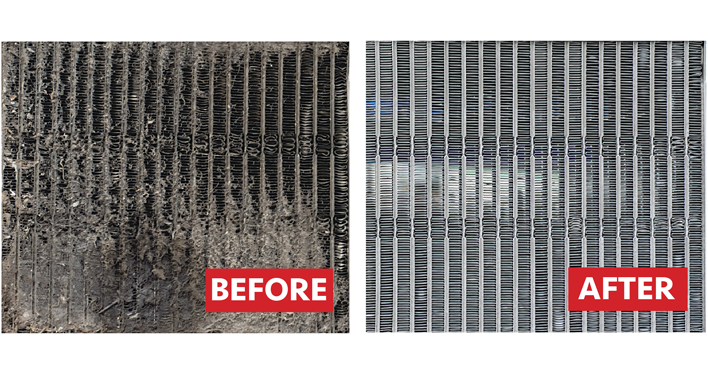How to Clean Commercial HVAC Coils: A Complete Guide
Maintaining clean HVAC coils is essential for optimal performance, energy efficiency, and extending the lifespan of your system. Regular cleaning can save you money on energy bills and prevent costly repairs down the line.
Dirty HVAC coils can significantly reduce system efficiency, sometimes increasing energy consumption by as much as 30%. That’s why it’s crucial to implement a regular coil-cleaning schedule, especially after installing new equipment. Just like a visit to the dentist, coil cleaning might not be something you look forward to—but it’s definitely necessary.
HOW DO I KNOW IF MY COILS ARE DIRTY?
While a scheduled maintenance plan is the best way to keep your coils in top shape, there are some signs that indicate when a cleaning is needed.
- Check the air pressure drop across the coil against the design specifications. If the pressure is higher than normal, it could mean the coil is dirty.
- For condenser coils, high refrigerant head pressure may signal dirt buildup. For DX evaporator coils, low suction pressure and poor airflow are common indicators.
- Visually inspect the coils. If they look grimy or clogged, it's time for a cleaning.
HOW OFTEN SHOULD COILS BE CLEANED?
Under normal conditions, commercial HVAC coils should be cleaned at least once a year. However, certain environments require more frequent attention:
- Condenser coils under extreme conditions: Clean quarterly.
- Units near saltwater (within one mile): Clean monthly.
- DX evaporator coils in corrosive environments: Clean quarterly.
- High fin density coils: Clean more frequently due to increased dirt accumulation.
HOW TO CLEAN A COIL:
Before starting, always disconnect and lock out the electrical power to avoid accidental activation. Avoid getting water into motors or electrical components to prevent damage.
Start by removing large debris and straightening any bent fins. Use a pressure washer with a 25–40 degree nozzle to clean the coil without damaging the delicate aluminum fins. Apply a non-acidic, alkaline-based cleaner such as Nu-Brite for condensers and Evap Pow’r-C for evaporators. These cleaners help lift dirt from deep within the coil.

If an acidic cleaner is required, follow the instructions carefully. Any leftover residue can damage the coil. Only use a soft-bristle brush for gentle scrubbing if needed. After cleaning, rinse thoroughly with a power washer or hose.
Always follow the manufacturer’s guidelines when using cleaning products. Using harsh or toxic chemicals improperly can cause serious harm to both people and equipment.
USE STEAM TO REDUCE MESS
For interior coils, steam cleaning is a great alternative. It’s effective and reduces water mess. Just be careful not to over-saturate the motor or electrical parts. Use low pressure and keep the steam parallel to the fins to avoid bending them.
A LITTLE MAINTENANCE GOES A LONG WAY
Properly maintained commercial HVAC coils can last many years. Condenser coils typically last 10–15 years, while DX evaporator coils can last 15–20 years. Water coils often last over 20 years. Even quality replacement coils can match or exceed OEM performance, especially if made with thicker materials.
However, environmental factors—like proximity to saltwater or corrosive substances—can shorten the life of your coils. So regular inspections and cleanings are key to long-term performance.
WHAT IF MY COIL IS COATED?
Coated coils offer extra protection against corrosion, but they still need regular cleaning. The coating can get dirty just like any other coil, so maintenance is just as important. Keeping the coil clean ensures the coating remains effective and lasts longer.

Have questions or need a quote? Feel free to reach out anytime. Proper care of your HVAC system can save you time, money, and headaches in the long run.
Written by: Stephen Barzelatto
Vice President of Nationwide Coils
Net Vegetable Bags typically include the following content:
1. Vegetable bag: This is a bag made of mesh material used for storing and transporting vegetables. It usually has a transparent appearance so that customers can see the vegetables in the bag.
2. Sealing tape: This is a tape used to seal and secure vegetable bags. It can be a plastic belt or Rubber band to ensure that the vegetables in the bag will not fall or be contaminated.
3. Labels: Some Net Vegetable Bags may have labels indicating the type, weight, origin, or other relevant information of the vegetables. This helps customers understand the source and characteristics of the vegetables in the bag.
4. Reusable: Net Vegetable Bags are usually reusable, which means customers can take the bags home and use them again to purchase vegetables. This helps reduce the use of disposable plastic bags and is more environmentally friendly.
5. Versatility: Some Net Vegetable Bags also have versatility, such as being used as fruit bags, seafood bags, or packaging bags for other foods. This enables them to function in different situations and applications.
Overall, Net Vegetable Bags are an environmentally friendly and reusable vegetable bag used for storing and transporting vegetables, providing convenience and protection.
Net Vegetable Bags,Best Net Bags,Orange Fruit Net Bag,Mesh Grocery Bag
Suzhou Yitengjia Extruded Net Packaging Co., Ltd. , https://www.plasticnetbag.com
